Whether you’re building or demolishing a structure, concrete saws are one of those tools that you just can’t sub out for something else. The carbide tipped teeth of concrete saws, and the power they produce is unrivalled in the world of power tools.
So, in this article, we’re going to try to break down some of the many differences between makes, models and types of concrete saw. As well as reviewing the best concrete saws on the market, we’ll look at types of concrete saws and what to look for when buying a concrete saw too.
More...
Top Pick


Premium Choice

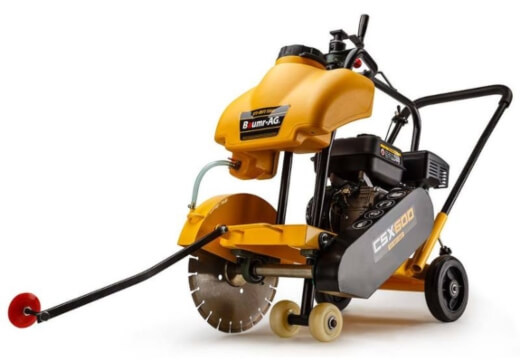
Best Value

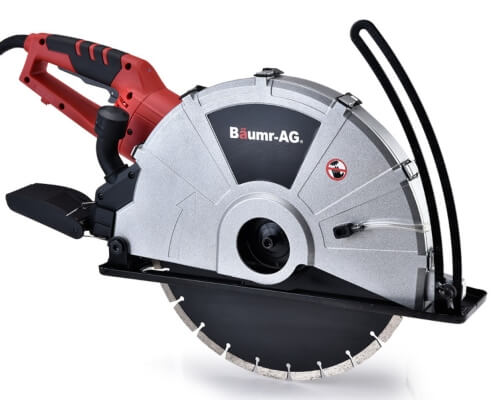
Product | Our Rating | Price | |
|---|---|---|---|
1. PowerBlade MX9500 Wet Demolition Saw |  |  | |
2. Baumr-AG Site-Mate Series CSX600 Concrete Saw |  |  | |
3. Baumr-AG CSE-75 Wet/Dry Electric Concrete Saw |  |  | |
4. Baumr-AG CSX75 Concrete Cut Off Demolition Saw |  | ||
5. Baumr-AG BM-WC52 Wall Chaser | |||
6. Roughneck ROU34460 Masonry Saw |
Concrete Saws Buying Guide
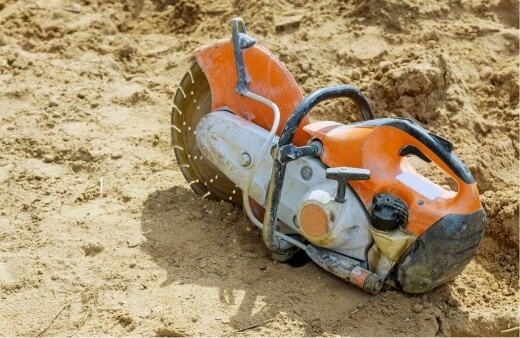
What is a Concrete Saw?
Concrete saws are heavy-duty power tools, designed to cut through concrete and sedimentary stone tiles, like sandstone or limestone. As a general rule, the bigger the saw, the more it can handle, and concrete saws stick to that rule pretty religiously.
From gigantic walk behind floor saws to tiny handheld wall chasers there is a concrete saw for every job. Stick with us to find out about the different jobs you can handle with different types of concrete saws.
What to Look for When Buying a Concrete Saw
When buying any concrete saw there are a few basic factors to look out for:
- Tips
- Power
- Safety
- Wet or dry
Power varies between models and the tasks each saw is designed for, but some things, like safety and tip strength, should always be top of your priorities when looking for the best concrete saws.
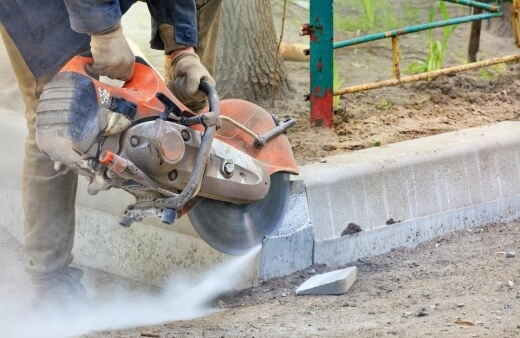
Tips (Tungsten carbide / Diamond tipped)
Concrete saws are typically sold with tungsten carbide tips. It’s fairly rare to find a concrete saw without them, but if you want to go a step further, look for a diamond-tipped concrete saw.
The blades on these saws are capable of producing a much neater cut and work perfectly in tandem with wet saws which provide water as a coolant and help reduce dust.
Power
Concrete saws come with anything from 0 horsepower to 14 horsepower on commercially available models (some demolition wire saws have much higher power, but are far too dangerous to use at home or on most building sites).
For cutting through concrete flooring or poured concrete, aim for something with around 7-14 HP, but for small jobs like wall chasing it’s rare that horsepower is even listed.
For smaller concrete saws, for blockwork, or channels, look for the blade strength, and around 7000 RPM.
Safety Features
Old fashioned concrete saws used to have something similar to a cycle mudguard to protect the use, but modern concrete saws have circular blade guards which protect the blade for flying out, and are incredibly effective at receding flying debris.
If you ever see a concrete saw without a blade guard DO NOT BUY IT. Blade guards are essential for all types and sizes of concrete saws other than hand saws.
Wet Saw vs Dry Saw
The question most often asked about concrete saws is whether you need a wet saw or dry saw for concrete. The answer lies more in the job you’re doing than the saw you’re using.


Get Your Free Guide:
Master Growing Australian Natives eBook
A Must Have Complete Guide for Every Australian Garden
Get Your Free Guide:
Master Growing Australian Natives eBook
A Must Have Complete Guide for Every Australian Garden
For any work where cutting will take over 30 seconds, wet saws are advised. This is simply because blades get hot, and water helps cool them, reduce friction, and reduce dust.
All of that combined makes wet saws much safer. But for indoor jobs like wall chasing, the dust will be minimal and you should be wearing a dust mask anyway, so wet saws can be a hassle that’s not worth taking.
Different Types of Concrete Saws (and how to use them)
There are seven types of concrete saw and each does a very different job. Our reviews focus on dry/wet concrete saws, floor saws, wall saws and hand saws for concrete, but chain saws and wire saw are excellent tools for commercial and structural work too:
- Dry saw
- Wet saw
- Chain saw
- Floor saw
- Wall saw
- Wire saw
- Hand saw
Dry saw

Source: dtwtools
Dry concrete saws are great for quick jobs but don’t offer much in the way of safety. If you’ve got a few paving slabs to trim or cut drainage holes out of dry saws can be effective, but we’d always advise wet saws for bigger jobs.
The good news is that most circular concrete saws sold today work as wet and dry saws, so are great for quick jobs, or can be topped up with water or lubricant to get through tougher concrete.
Wet saw

Source: cdnassets.stihlusa
Wet saws for concrete have water fed to the blade so there is a constant supply of fresh water to dampen dust, reduce potential sparks and high temperatures, as well as keep a clean, dust-free area for cutting.
If you’ve ever sawed concrete the old fashioned way, you’ll know exactly what I mean, but it's similar to sawing timber without an extractor. Dust builds up and reduces visibility, and can even cover the cutting line making it difficult to get straight lines without wet saws.
Some wet saws have hose attachments which are great for extended cuts, but for quick jobs, smaller wet concrete saws have water bottles which provide a slow drip-feed instead of a tap connection.
Chain saw
Chain saws for concrete are the same as chainsaws for timber but with much tougher chains. It’s crucial to buy diamond-tipped blades, but probably more importantly is the type of chain.
Concrete chainsaw chains have long, shallow links which effectively strip and sand through concrete and masonry, rather than biting at it like timber chains.
The best concrete chainsaws are petrol though, as the extra power really helps to work through the tough material. Check out our guide to buying the best chainsaws, but make sure you pick one that’s suitable for masonry or concrete chain.
Floor saw

Source: bwmachinery
Floor saws, or demolition saws are the biggest concrete saws, and should only be used with proper training or by professionals. Concrete floor saws absolutely need a water feed as they are designed to cut right through poured concrete.
If you’re happy to use these huge machines, bear in mind that they cost a lot of money, and you should always check drainage and electric plans for any property before using them to avoid cutting through essential services.
Wall saw / Wall chaser
Wall chasers are really handy tools, especially for home renovation as they can cut incredibly neat lines through plaster, concrete and masonry, making it easy to install new electrics easily without any sign of damage when you plaster back over.
Like all concrete and masonry saws, wall saws are best used with a water feed, but for indoor use, it can be messy, so it’s often fine to work without water when using wall chasers. Just be sure to wear goggles and a mask.
Wire saw
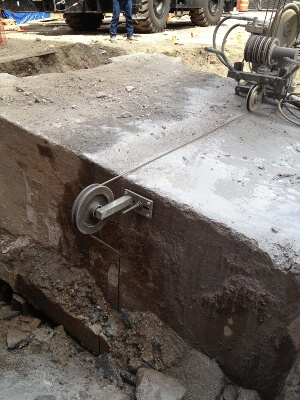
Source: easterncutting
Concrete wire saws are heavy machines which are secured to the sides of buildings, floors, or poured concrete structures and use a spinning metal wire to work through concrete.
There are no domestic uses for concrete wire saws, and contractors are unlikely to need wire saws unless there is serious structural demolition work being done.
Hand saw
Concrete hand saws, or block saws are designed for one purpose – sawing breeze blocks. The lightweight concrete bricks that make up most of today’s housing developments, and are great for quick DIY garden jobs are easy to saw through with tungsten carbide tipped saws.
You’ll notice the significant difference in tooth spacing between concrete saws and standard timber saws.
Concrete Saw Safety Guide
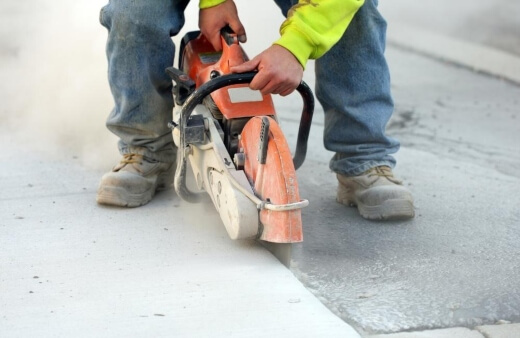
Concrete saws have two sets of safety guidelines: short-term, and long-term. Short-term safety with concrete saws is pretty obvious:
- Wear steel toe capped boots
- Wear goggles
- Wear a hard hat
- Wear heavy-duty gloves
- Make sure wires are behind you while cutting
- Keep blades sharp
- Keep water topped up
Long terms safety might not seem that important at first, but concrete saws are loud, dust machines, which can have serious impacts on your long-term health if not accounted for during use:
- Earplugs are a must with concrete saws to protect your hearing and prevent the development of tinnitus or short-term infection from dust
- Heavy duty dust masks are a requirement for operating concrete saws. Not only in the short term, but they can prevent lung damage, and blockages over the long term too.
Concrete Saws Reviews
1. PowerBlade MX9500 Wet Demolition Saw

PowerBlade MX9500
If you’re serious about DIY and are thinking of trying out ground working yourself, then this lightweight road cutter from Powerblade is ideal. It’s packed with safety features, is beautifully weighted, and its engine is really well-placed to reduce rocking.
For anyone new to concrete sawing, or to sawing with power tools like this, it’s best to start safe and the Powerblade systems are designed with safety in mind.
The wet feed runs to both sides of the blade, with a twin stage air filtration system which helps clean dust from the air while you work.
Pros
Cons
2. Baumr-AG Site-Mate Series CSX600 Concrete Saw

Baumr-AG CSX600
Most modern circular saws you’ll have in the garage, or workshop, are fitted with laser guides these days, so you might wonder what the deal is with concrete saws still coming with old fashioned folding guides?
Well, biblically, if it isn’t broke, don’t fix it. Fold-out guide lines for concrete saws, demolition saws and road saws have worked for decades, and as they are typically petrol tools it’s easier not to power lasers with convertors.
Provided you keep your guides tightened, they’ll give a true guide for years.
We’re getting into the really powerful tools now, with a 7HP engine, and a blade capable of cutting down to 8cm. There are blades that can cut deeper, but you’ll not get results as quickly or as cleanly as with tools of this calibre.
Pros
Cons
3. Baumr-AG CSE-75 Wet/Dry Electric Concrete Saw

Baumr-AG CSE-75
Baumr-AG’s 355mm circular concrete saw is one of the most versatile concrete saws we’ve ever found. Its deep cutting ability makes it incredibly adaptable, and great for use on soft concrete blocks, as well as poured concrete.
The electric motor isn’t as powerful as petrol saws, but it will work through most materials that a road saw can handle, if a little bit slower. What’s really great about this saw from Baumr-AG is how simple it is to operate.
The well-balanced tool makes it super intuitive, with the weight always away from the user, and the adjustable blade guards mean it can reach down to a depth of 125mm, making it the deepest concrete saw on review this year.
Pros
Cons
4. Baumr-AG CSX75 Concrete Cut Off Demolition Saw
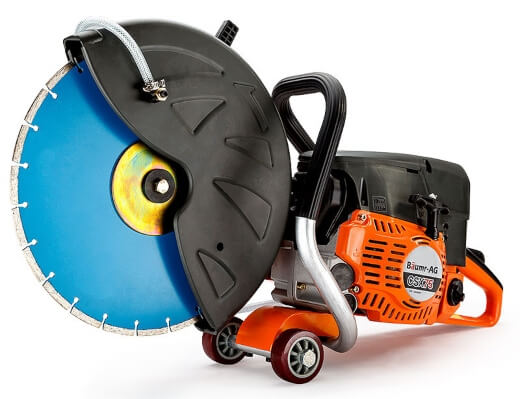
Baumr-AG CSX75
I love that Baumr-AG is still in that place where they’re trying to catch the market with offers and freebies. Honestly, Baumr might not be a household name like Makita or Husqvarna yet, but they’ve earned enough trust with their tools to not need to be giving stuff away!
Even so, it’s great that this demolition saw comes with a free water feed that easily attaches to your hose, and a blade worth over $150!
This is Baumr’s lowest power demolition saw, so perfect for anyone aiming for household use, rather than commercial concrete saws as it is fairly lightweight, packs away well, and will deal with most poured concrete surfaces and block work easily.
Pros
Cons
5. Baumr-AG BM-WC52 Wall Chaser
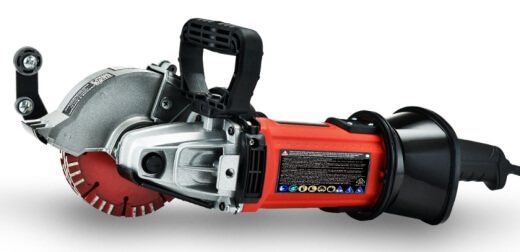
Baumr-AG BM-WC52
We know now everyone will be looking for wall chasers, but the reality is when you need one you need one, and these compact concrete saws are perfect for cutting neat channels out of concrete, either for pipework, electricals or detailing.
Baumr-AG has produced the best wall chaser we’ve seen, capable of neatly cutting 30mm grooves that are 41mm deep, ideal for laying wiring or small pipework through concrete.
The retracting blade guard is a super-clever addition too, meaning the blades can get right into corners without having to carve out the final inch with chisels.
Pros
Cons
6. Roughneck ROU34460 Masonry Saw

Roughneck ROU34460
If you’re putting together a new BBQ, or starting on an outdoor structure, block saws are perfect for the job, giving you full control over accurate cuts through lightweight concrete blocks.
There’s no need for expensive saws if all you’re cutting are breeze blocks, so try a hand saw for concrete like this one from roughneck. The biggest bonus is that it is stored easily, and won’t waste space in the garage when you’re done with it. But remember, these saws are designed for light concrete only, and should never be used on anything other than breeze blocks.
Pros
Cons
Concrete Saw Top Picks for 2025
Concrete Saw - Our Top Pick


PowerBlade MX9500
Powerblade is dedicated to creating commercial-grade tools that work for domestic users. There are so many road cutters on the market that assume contractors are trained, and therefore don’t need safety features, but Powerblade’s latest models prove that you can create tools that work, without cutting back on safety.
The MX9500 is one of the best concrete saws you can buy, especially for DIY, as it is capable of demolition work as well as more intricate cutting for paving slabs and finishing touches around the garden. The hose attachment is convenient and helps keep the weight on the machine down too.
Premium Choice Concrete Saw


Baumr-AG CSX600
There are more expensive concrete saws on the market, but we just can’t fault Baumr’s road saw with an accurate 80mm cutting depth and a powerful 7HP engine, making it perfect for almost every job.
The entire machine is well balanced, but on top of that, it’s simple to operate, safe, and has a good-sized water tank, which isn’t too heavy, but holds enough water (12L) for around twenty minutes of cutting. Also, not that it matters, but it looks good too. I know we always get told off for saying that tools look good when it’s practicality that matters, but honestly, this is a really good looking machine!
Best Value Concrete Saw


Baumr-AG CSE-75
Concrete saws don’t have to be heavy beasts. They can be functional, lightweight tools that have a balance on their side. Baumr-AG proves that with this beautifully mid-range tool which is suitable for DIY users as well as smaller commercial jobs too.
The adjustable blade guard allows this concrete saw to cut right down to a depth of 125mm, which is astonishing given that it’s a plug-in electric tool, but it's 2400W motor have enough power to sluice through most concrete, and its water feed helps keep the entire cut surface clean and dust-free at the same time.
Concrete Saws FAQs
How deep can a concrete saw cut?
An average concrete saw blade has a diameter of around 35cm, and can usually cut to a depth of 8.5cm deep. Different blades have different capabilities of course, with some walk-behind concrete saws able to cut up to 20cm deep, and wall chasers typically able to cut less than 3cm.
Can you cut concrete with a grinder?
For small work like taking corners off concrete blocks, or thinning the edge of a tile, grinders are perfect little tools for cutting concrete. They are not as efficient, and can easily overheat if cutting larger amounts of concrete, and their blades will quickly wear down, but for convenience, grinders can definitely be used to cut concrete.
What is a concrete cutter called?
Concrete saws, also known as consaws, slab saws, wall chasers, block saws or road saws are sold under many different names, but all give a good indication of the capability of each model.
For example, a wall chaser is designed for cutting small grooves in walls and is much less powerful than a road saw, which is designed as a walk-behind piece of plant machinery.
How long does a concrete saw blade last?
Concrete saw blades can last for up to 120 hours of continuous use, but the diamond tips and carbide will begin wearing after around 12 hours of use. Buying the best quality concrete blades will elongate the life of your concrete saw.
For more power tools you might need, see our buyers' guide list below:

Wrapping Up Our Concrete Saw Guide
There really are no other tools that can replace concrete saws for efficiency, safety, and practicality when it comes to cutting through paving and blockwork. But, finding the best concrete saw is complicated, so you came to the right place.
Hopefully, we were able to settle some of the dust around the different types of concrete saws, and if nothing else, point you in the direction of some of the best concrete saws on the market.
Published on May 29, 2022 by Gary Clarke
Last Updated on December 27, 2025




